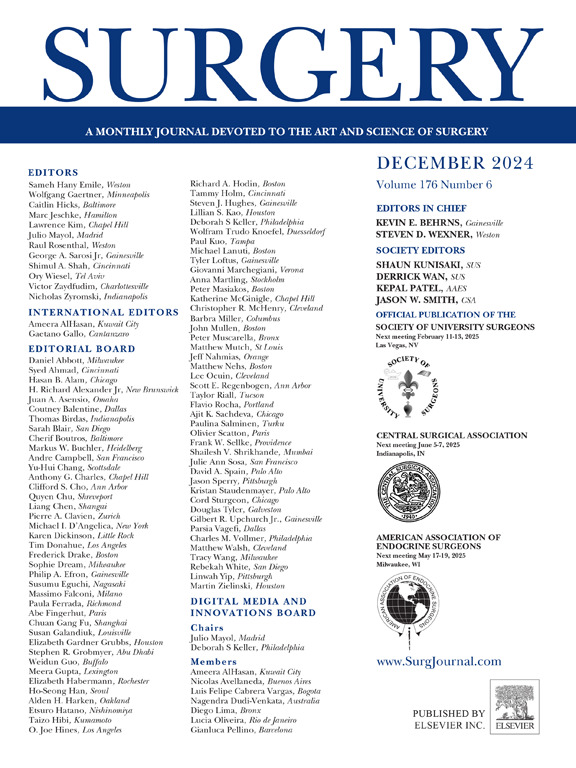Effect of systemic FOLFOXIRI plus bevacizumab treatment of colorectal peritoneal metastasis on local and systemic immune cells
IF 2.7
2区 医学
Q1 SURGERY
引用次数: 0
Abstract
Aim
The immune system plays a crucial role in the outcome of colorectal cancer. Systemic chemotherapies modulate the immune cell composition. Little is known about these changes in peritoneal metastasized colorectal cancer. Thus, we aimed to characterize local and systemic immune cells in the course of systemic chemotherapy.
Methods
We included in total 20 patients with peritoneal metastasized colorectal cancer in our exploratory study. Initially, we investigated the peripheral blood cell distributions before and after systemic chemotherapy in a set of 11 retrospectively collected samples. Then, a prospective clinical cohort was set up to evaluate local and systemic immune cell distribution in detail (n = 9). Tumor tissue, peritoneal fluid, and peripheral blood were collected. The main immune cell subtypes were characterized using flow cytometry and immunohistochemistry, respectively.
Results
Neutrophils and the neutrophil-to-lymphocyte ratio significantly declined in response to systemic chemotherapy while circulating T cells increased (CD8+ P = .015, CD4+ P = .041). In peritoneal fluid, we observed a decrease of CD25+/FOXP3+/CD4+ regulatory T cells (P = .049) without loss of their ability to produce interferon gamma. T-cell infiltration in the tumor microenvironment showed a considerable variability between patients. However, the number of tumor-infiltrating CD8+ lymphocytes was not significantly changed by the application of systemic chemotherapy. Neither tumor cells nor lymphocytes or macrophages showed noteworthy expression of PD1 or PD-L1.
Conclusion
Our data show that immune cell distribution after systemic chemotherapy changes in peripheral blood. Interestingly, in peritoneal fluid only the inhibitory Treg population decreased and local T cells within peritoneal metastases remain unaffected. These data indicate little to no effect of systemic chemotherapy on the local immune system, supporting the need for new therapeutic options.
FOLFOXIRI 加贝伐单抗全身治疗结直肠腹膜转移瘤对局部和全身免疫细胞的影响
目的:免疫系统对结直肠癌的预后起着至关重要的作用。全身化疗可调节免疫细胞的组成。人们对腹膜转移性结直肠癌中的这些变化知之甚少。因此,我们旨在描述全身化疗过程中局部和全身免疫细胞的特征:我们的探索性研究共纳入了 20 名腹膜转移性结直肠癌患者。首先,我们在一组回顾性收集的 11 份样本中调查了全身化疗前后的外周血细胞分布情况。然后,我们建立了一个前瞻性临床队列,以详细评估局部和全身免疫细胞的分布情况(n = 9)。研究人员收集了肿瘤组织、腹腔液和外周血。分别使用流式细胞术和免疫组化鉴定了主要的免疫细胞亚型:结果:中性粒细胞和中性粒细胞与淋巴细胞的比值在全身化疗后显著下降,而循环T细胞增加(CD8+P = .015,CD4+P = .041)。在腹腔液中,我们观察到CD25+/FOXP3+/CD4+调节性T细胞减少(P = .049),但它们产生γ干扰素的能力并未丧失。肿瘤微环境中的 T 细胞浸润在不同患者之间存在很大差异。但是,肿瘤浸润的 CD8+ 淋巴细胞的数量并没有因为全身化疗而发生显著变化。肿瘤细胞、淋巴细胞或巨噬细胞均未出现值得注意的 PD1 或 PD-L1 表达:我们的数据显示,全身化疗后外周血中的免疫细胞分布发生了变化。有趣的是,腹腔液中只有抑制性 Treg 群体减少,腹膜转移灶内的局部 T 细胞不受影响。这些数据表明,全身化疗对局部免疫系统几乎没有影响,因此需要新的治疗方案。
本文章由计算机程序翻译,如有差异,请以英文原文为准。
求助全文
约1分钟内获得全文
求助全文
来源期刊

Surgery
医学-外科
CiteScore
5.40
自引率
5.30%
发文量
687
审稿时长
64 days
期刊介绍:
For 66 years, Surgery has published practical, authoritative information about procedures, clinical advances, and major trends shaping general surgery. Each issue features original scientific contributions and clinical reports. Peer-reviewed articles cover topics in oncology, trauma, gastrointestinal, vascular, and transplantation surgery. The journal also publishes papers from the meetings of its sponsoring societies, the Society of University Surgeons, the Central Surgical Association, and the American Association of Endocrine Surgeons.
 求助内容:
求助内容: 应助结果提醒方式:
应助结果提醒方式:


